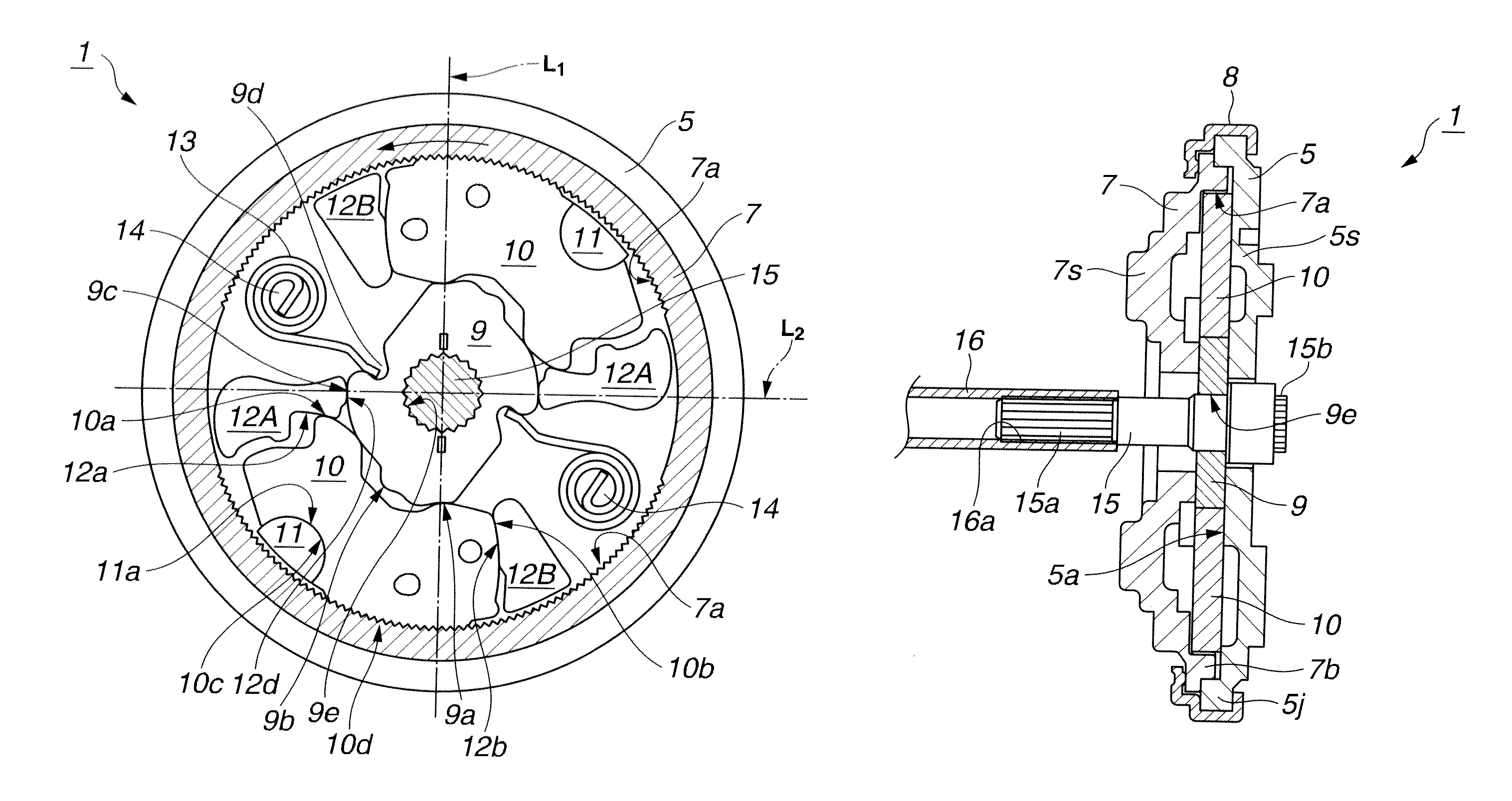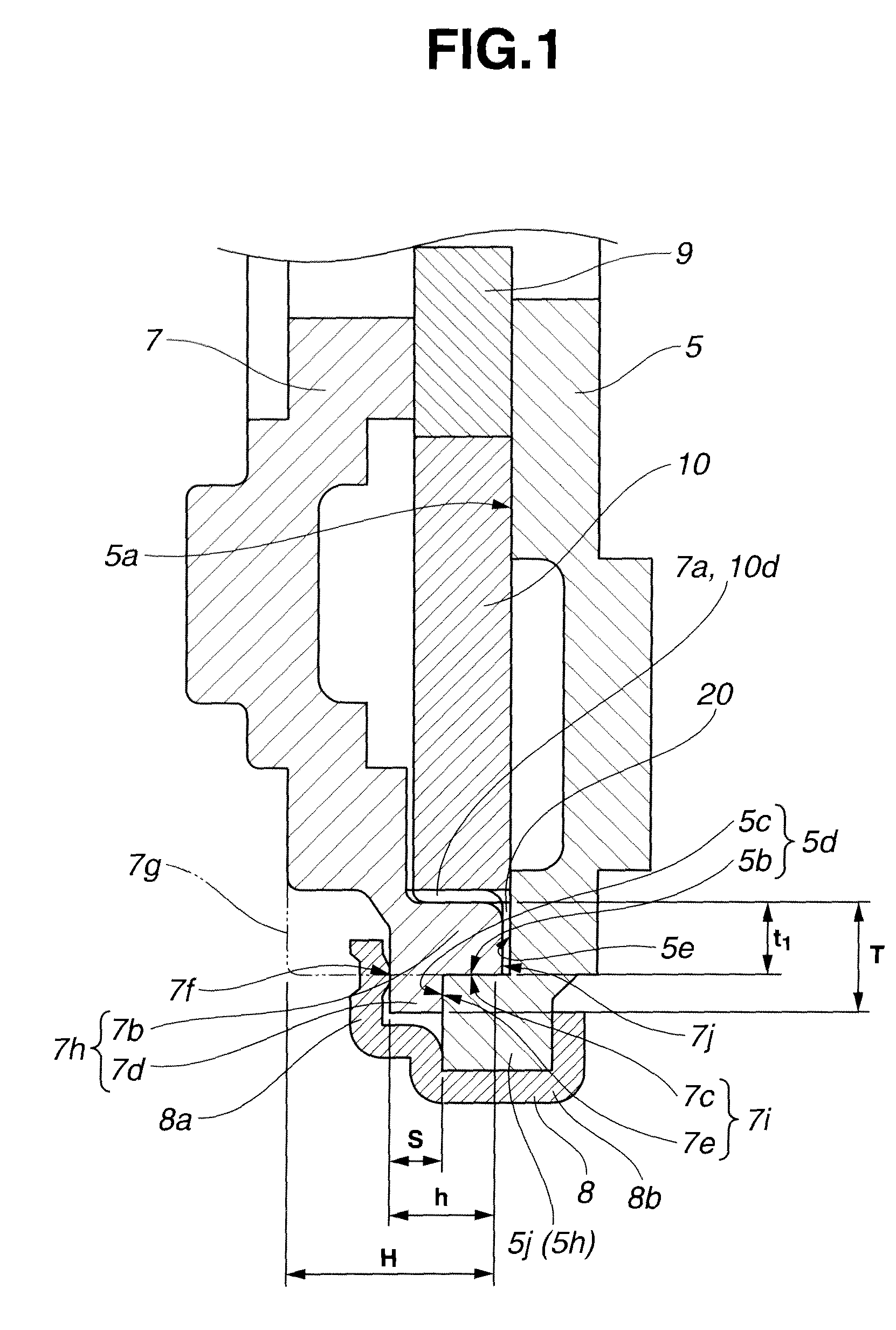Vehicle seat reclining apparatus
a vehicle seat and apparatus technology, applied in the field of vehicles, can solve the problems of small regulating member, prone to bend, decrease in lock strength, etc., and achieve the effects of increasing the axial length of the cylindrical portion, reducing lock strength, and increasing the plate thickness
- Summary
- Abstract
- Description
- Claims
- Application Information
AI Technical Summary
Benefits of technology
Problems solved by technology
Method used
Image
Examples
first embodiment
[0014
[0015]A vehicle seat shown in FIG. 6 includes a seat cushion 2 serving as a seat portion on which a seat occupant sits, and a seat back 3 connected with seat cushion 2 in such a rotatable manner that seat back 3 can rotate back and forth in the longitudinal direction of the vehicle. In this example, a frame member 5 serving as a base member is connected with seat cushion 2 through a base plate 4. A cover or lid member 7 (not shown in FIG. 6) serving as a rotation member is connected with seat back 3 through an arm plate 6. A spring (not shown) is provided for urging the seat back 3 in a leftward direction which is a forward direction toward the front of the vehicle, relative to the seat cushion 2.
[0016]The frame member 5 and cover member 7 are constituent members of a vehicle seat reclining mechanism 1 shown in FIGS. 2A and 2B, as explained below. As shown in FIG. 2B, frame member 5 includes a circular recess 5a formed by half blanking of a circular plate with a press. Frame me...
second embodiment
[0041
[0042]FIG. 3 shows a vehicle seat reclining mechanism according to a second embodiment of the present invention. The second embodiment is basically the same as the first embodiment so that repetitive explanation is omitted by using the same reference numerals for the same parts. The following explanation is directed to feature of the second embodiment different from the first embodiment.
[0043]As shown in FIG. 3, the end surface 7j of the cylindrical portion 7b of cover member 7 is put in sliding contact with the bottom surface (confronting center wall surface) 5e of circular recess 5a of frame member 5. Thus, the end surface 7j is used as the (flat) sliding side surface. The first side surface 7e of flange 7d is spaced axially from the end surface 5c (confronting surface) of rim portion 5j of frame member 5 by a clearance 21. This clearance 21 is set to have a dimension (such as an axial dimension in the axial direction) to prevent contact between surfaces 7e and 5c even in the...
third embodiment
[0046
[0047]FIG. 4 shows a vehicle seat reclining mechanism according to a third embodiment of the present invention. The third embodiment is basically the same as the second embodiment so that repetitive explanation is omitted by using the same reference numerals for the same parts. The following explanation is directed to feature of the third embodiment different from the second embodiment.
[0048]The seat reclining mechanism shown in FIG. 4 is different from the mechanism shown in FIG. 3 according to the second embodiment only in the structure connecting the first side portion 8b of holder 8 (regulating member) to the outer circumferential portion 5h(5j) of frame member 5 (base member). The first side portion 8b of holder 8 of FIG. 4 extends straight in the axial direction and has no first side radial wall extending radially inwards on the first (right) side of outer circumferential portion 5h(5j) of frame member 5 to clamp the outer circumferential portion 5h (5j), unlike the first...
PUM
 Login to View More
Login to View More Abstract
Description
Claims
Application Information
 Login to View More
Login to View More - R&D
- Intellectual Property
- Life Sciences
- Materials
- Tech Scout
- Unparalleled Data Quality
- Higher Quality Content
- 60% Fewer Hallucinations
Browse by: Latest US Patents, China's latest patents, Technical Efficacy Thesaurus, Application Domain, Technology Topic, Popular Technical Reports.
© 2025 PatSnap. All rights reserved.Legal|Privacy policy|Modern Slavery Act Transparency Statement|Sitemap|About US| Contact US: help@patsnap.com



